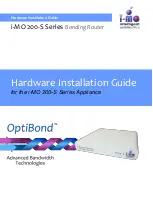
RangeMax Dual Band Wireless-N Modem Router DGND3300 User Manual
Fine-Tuning Your Network
7-8
v1.0, January 2010
Changing the MTU Size
The Maximum Transmission Unit (MTU) is the largest data packet a network device transmits.
When one network device communicates across the Internet with another, the data packets travel
through many devices along the way. If any device in the data path has a lower MTU setting than
the other devices, the data packets must be split or “fragmented” to accommodate the one with the
smallest MTU.
The best MTU setting for NETGEAR equipment is often just the default value, and changing the
value might fix one problem but cause another. Leave MTU unchanged unless one of these
situations occurs:
•
You have problems connecting to your ISP or other Internet service, and the technical support
of either the ISP or NETGEAR recommends changing the MTU setting. These might require
an MTU change:
–
A secure website that won’t open, or displays only part of a Web page
–
Yahoo e-mail
–
MSN
–
America Online’s DSL service
•
You use VPN and have severe performance problems.
•
You used a program to optimize MTU for performance reasons, and now you have
connectivity or performance problems.
If you suspect an MTU problem, a common solution is to change the MTU to 1400. If you are
willing to experiment, you can gradually reduce the MTU from the maximum value of 1500 until
the problem goes away.
Table 7-2
describes common MTU sizes and applications.
Note:
An incorrect MTU setting can cause Internet communication problems such as the
inability to access certain Web sites, frames within Web sites, secure login pages,
or FTP or POP servers.
Table 7-2. Common MTU Sizes
MTU
Application
1500
The largest Ethernet packet size and the default value. This is the typical setting for non-
PPPoE, non-VPN connections, and is the default value for NETGEAR routers, adapters,
and switches.
1492
Used in PPPoE environments.
















































